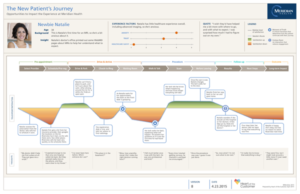 In every customer journey, some interactions matter more than others. There are certain moments that cause customers to leave you, some that potentially lead to stronger engagement, and some that cause a customer to be much more expensive to serve.
In every customer journey, some interactions matter more than others. There are certain moments that cause customers to leave you, some that potentially lead to stronger engagement, and some that cause a customer to be much more expensive to serve.
We call these key interactions a “Moment of Truth,” and it is one of the most important findings of customer experience research, including journey mapping. Because these moments have a disproportionate impact on long-term loyalty, you need to make them a focus of your attention.
The term Moment of Truth has been used in different ways. We trace our usage back to P&G’s work. They described product packaging as being the first moment of truth – that is, the packaging often determines whether a customer decides to purchase or not.
Moments of Truth vary between customer segments. We’ve found that Moments of Truth are disproportionately found in three stages of the journey:
* The beginning
* The end
* When hand-offs occur between silos
If the beginning goes badly, it may also be the end. In P&G’s case, a bad package could mean the customer never buys. But the end of the journey has equal, if not greater, importance. As Daniel Kahneman discovered in his Nobel Prize-winning research, the ending is one of the key determinants to how we remember the journey. This can then have a very strong impact on whether we’re willing to use this company for future journeys. The third occasion likely to see a Moment of Truth is during a hand-off, which may be rife with frustrating problems for the customer.
The identification of Moments of Truth is huge, but it is only half of the battle. Solving problems that occur during Moments of Truth in a way that meets your customer’s true needs is critical to success. Some examples:
B2B new customers. In many B2B new-customer journeys, the transition from prospect to customer is a critical time, especially when sales is only responsible for “hunting” for new customers, and another department manages existing clients. Sales sets the customer’s expectations – and when they’re not part of the ongoing relationship, it’s all too easy for those expectations to fall short of reality. Some fixes of this problem from our clients have included delaying the transition from sales rep to account manager, an internal hand-off meeting where expectations are clearly explained, and more effective documentation in the CRM system. (Although getting the sales team to complete that is another issue…)
Onboarding new B2B customers. We worked with a Software as a Service (SaaS) provider who discovered just how important their onboarding process was. Clients who rated onboarding highly were significantly more likely to renew their subscription. Those who were not effectively onboarded never fully learned to use the system. As a result, they didn’t realize the positive business impact available through the software, so saw no reason to renew.
Onboarding new B2C customers. We helped a fitness center client discover three personas, including one who is new to health clubs. She joined to help her family get fit, figuring she’d also enjoy the services. The beginning of the journey was a moment of truth for her. Because this is the first time in her life that she’s joining a club, she’s overwhelmed by the experience. Our client focused on creating a more personal onboarding experience to help her learn about the options available to her. They also had the novel idea of having their usability group redesign their printed schedule.
Ending the patient appointment well. Our case study featured in the book Mapping Experiences (Kalbach) included the experience of Newbie Natalie, one of three personas discovered in the course of our research. Natalie is new to the radiology experience, and the way the appointment ended determined whether she would return to our client for future appointments. If she leaves without understanding what happened and what comes next, her frustration leads her to look for a new provider next time.
We all want every part of the journey to be perfect. That’s why we chose customer experience as a discipline – and as a passion! But it’s important to remember that not every piece of the journey can always be perfect. It’s critical to understand which are really Moments of Truth – and focus your perfection on those moments. In this way, you will build long-term loyalty.
Want to discover your own Moments of Truth? Download our Journey Mapping Toolkit!




Jim, I have a question- how distinctive do you see moments of truth needing to be delivered? If the moment is truly critical in the journey, wouldn’t all providers seek to focus on it? Doesn’t that risk such moments as actually becoming hygiene moments over time?
Rick, you’re getting to the heart of the matter. First, we should distinguish between positive and negative moments of truth. A positive moment of truth – such as a powerful welcome – is likely universal to brands. Yes, each player in a space will likely focus on this. But how they do it will vary. And, as you suggest, the requirements for success will increase over time, as different competitors all improve their game there. I don’t necessarily agree that they become hygiene moments over time, although that can certainly be true. Rather, I think the requirements for excellence will increase over time.
The second, though, is negative moments of truth – areas that you’re not executing on well today, and are costing you loyalty. These are often unique to a particular company, and their current experience. As these are improved, they may no longer become moments of truth, and others may pop up.